Continuing our four-part series on Sullivan’s Gulch. The first chapter examined homestead and early railroad history. In this chapter we explore how manufacturing shaped the area during the first half of the 20th Century.
In the early 1900s, the railroad came to define Sullivan’s Gulch, connecting Portland to points east and serving a growing manufacturing presence in the gulch proper and along its shoulders.
From The Oregonian, May 7, 1911.
Engineers had filled in the marshlands at the mouth of the gulch where it met the Willamette River in an attempt to keep seasonal flooding from damaging rail infrastructure. On frigid months, the ponds that formed there—about where today’s I-84 merges with Interstate 5—were used as ice skating rinks by residents of nearby eastside neighborhoods. Other nearby gulches were used as sewers and dumping grounds, some were filled in.
The rails up the gulch were necessary infrastructure for a growing Portland, and they were a major attraction, particularly for neighborhood kids. Here’s a memory from former resident Bob Frazier, shared in the January 27, 1952 edition of the Oregon Journal:
“The gulch was a terrible place for kids, but at the time it was wonderful. In a way, living by the gulch was something like living next to a roundhouse. The trains puffing through Sullivan Gulch never failed to attract us and stir our fiendish little imaginations. Whenever we could sneak away from home for a few minutes, our crowd of 4 and 5-year-olds would bee-line for the gulch to watch No. 17, which as I recall came through sometime between nap-time and supper-time. The whistle of No. 17, screeching toward the Willamette, will, I fear, become meaningless to the next generation.”
For Frazier and his gang—and several generations of kids as surrounding neighborhoods built up—the gulch was a land of forbidden adventure that included digging caves into the slopes, hunting pheasants, building rope swings, playing with fire, and playing in deep puddles.

The legendary Oregon Railway & Navigation Engine 17 passing under the NE 33rd Avenue viaduct, January 20, 1929. The Beaver State Furniture building to the left is today’s graffiti-covered former Gordon’s Fireplace Shop at NE 33rd and Broadway. Note how much narrower the gulch was than today: major widening in the 1950s made room for the Banfield Expressway, requiring replacement of the viaduct.
Heavy manufacturers quickly found the value and utility of locating their factories along the rail line in the bottom of the gulch and along its sides: cheap close-in property not suitable for residential development; easy trans-shipment of products to distant markets; good access to workers from eastside neighborhoods, including a handy link with the streetcar system.
In 1899, the Doernbecher Manufacturing Company acquired five acres of property in the gulch at NE 28th on the north side of the tracks, where they built what The Oregon Journal referred to as “The biggest furniture factory under one roof in the world.”

From The Oregon Journal, December 25, 1904.
With thousands of factory workers reporting to this area each day, access and transportation became crucial. In 1902, a viaduct at 28th carried the 28th Street Streetcar on a spur north from the Montavilla line across the gulch where it stopped at Halsey. Two large stairways led down the north side of the gulch to the factory below. Today, it might be hard to imagine all of the activity in this area, but up until the 1940s (and the booming shipyards associated with the war effort), the Doernbecher factory had the largest industrial payroll in the Portland area.
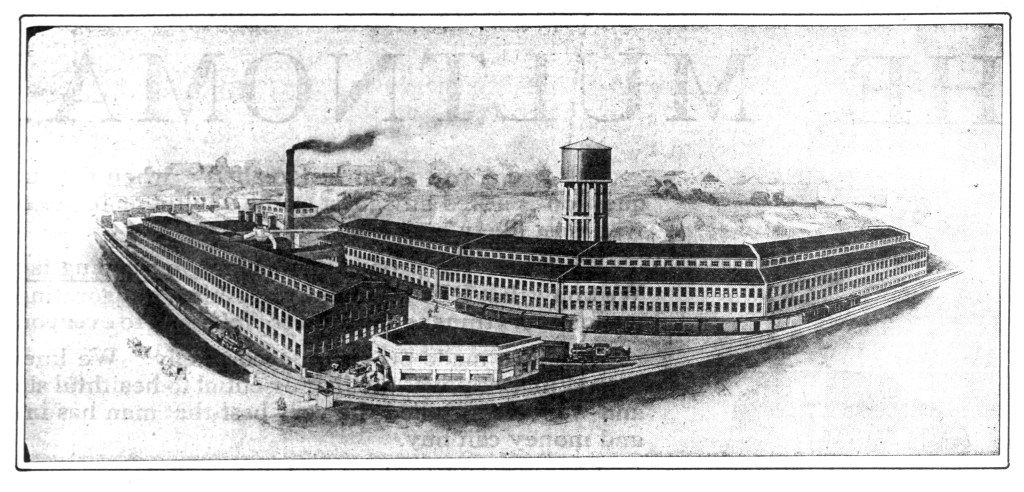
A view of the Doernbecher Furniture Factory, looking toward the northwest, from The Oregonian, February 25, 1912. The bluff of Sullivan’s Gulch is visible behind.
By the early 1930s, residential development had completely surrounded the Doernbecher factory and while the neighbors appreciated the employment opportunities, they were having a hard time breathing and were tired of cleaning up the soot that came out of the Doernbecher chimneys.
The factory generated its own power from wood-fired boilers that belched thick smoke and ash. In August 1933, neighbors lined up to protest at city hall, including a demonstration that left an impression on at least one newspaper reporter from the Oregon Journal, writing on August 26, 1933:
“The protestants, in virtually every talk that was made, urged that they did not desire the factory removed or shut down, that they are in full sympathy with the undertaking to give more employment but that they do feel that they have submitted to the smoke nuisance as long as it can be endured and are entitled to relief.”
“A spectacular feature of the hearing was the marching up to the council desk, where the committee sat, of groups of housewives and their depositing on the desks of bags and packages of soot and cinders they had swept up in their homes.”
Company president Harry A. Green was actually arrested on October 15,1935 for continuing to ignore a city ordinance about nuisance smoke. In a hearing that week before Municipal Judge Donald E. Long, Green threatened to close and liquidate the company.
From The Oregon Journal, October 16, 1935 (left) and The Oregonian, March 21, 1936
Here’s another look at the factory—this one taken in 1947—showing that the company didn’t actually close, but continued with its operations, and with heavy smoke. In fact, the factory continued to operate until 1955 when it closed, according to Harry Green, due to unfavorable union negotiations. Today, the area functions as a giant public storage facility and in a fitting twist of history, hosts several small craft furniture studios.

Looking northwest, NE 28th and Sandy crossing at a diagonal left to right, 1947. The NE 28th Avenue viaduct spans the gulch, and a portion of the roof of the Doernbecher plant. Note the smoke plume. Source: City of Portland Archives A2005-001-577.
The street that today leads down into the gulch, under the Banfield, across the tracks and into the old factory building? It’s NE Sullivan Street.
The former Doernbecher Furniture Factory today, Google Streetview.
Just up-gulch to the east, where the ravine bends to the north, was more heavy industry and manufacturing. First a foundry, then a machine shop and other metal manufacturing, the site of today’s Hollywood West Fred Meyer eventually became the sprawling industrial campus of Willamette Hyster, later known simply as Hyster, where the company made forklifts and other heavy equipment. Hyster operations in the gulch began in the 1940s and took over parts of the surrounding neighborhood. Over the years, Hyster acquired and demolished an estimated 17 nearby homes on the flats above the gulch north and west of the factory to make room for its operations

Detail of a 1960 aerial photo that shows the location of Hyster and its neighbors. The red outline is the approximate location of today’s Hollywood West Fred Meyer. Note that the NE 33rd exit off the Banfield was east of 33rd. Photo courtesy of University of Oregon Map and Aerial Photography Library.
Hyster’s immediate gulch neighbor to the northeast was Albina Fuel, a storage yard for all things combustible: wood, sawdust, coal and heating oil. And all surrounded by a growing neighborhood that was closing in on both sides of the gulch (and within two blocks of a busy elementary school).

An early 1940s view looking south (Broadway in the foreground) at Albina Fuel at Broadway and 33rd. The viaduct over the gulch is visible in the background, with neighborhood houses just beyond. Photo courtesy of Albina Fuel.
It wasn’t just heavy manufacturing at this big bend in the gulch: A factory built in 1911 by the Oregon Home Builders at the southeast corner of 33rd and Broadway—which many of us probably remember as Gordon’s Fireplace Shop and Tarlow’s Furniture before that—was a huge cabinet and carpentry shop for its first few years.
Oregon Home Builders constructed its built-ins and kitchen cabinetry here until charismatic company president and budding pilot Oliver K. Jeffery transformed it—briefly in 1917 until funding reality caught up—into a place where spruce aircraft parts were built.
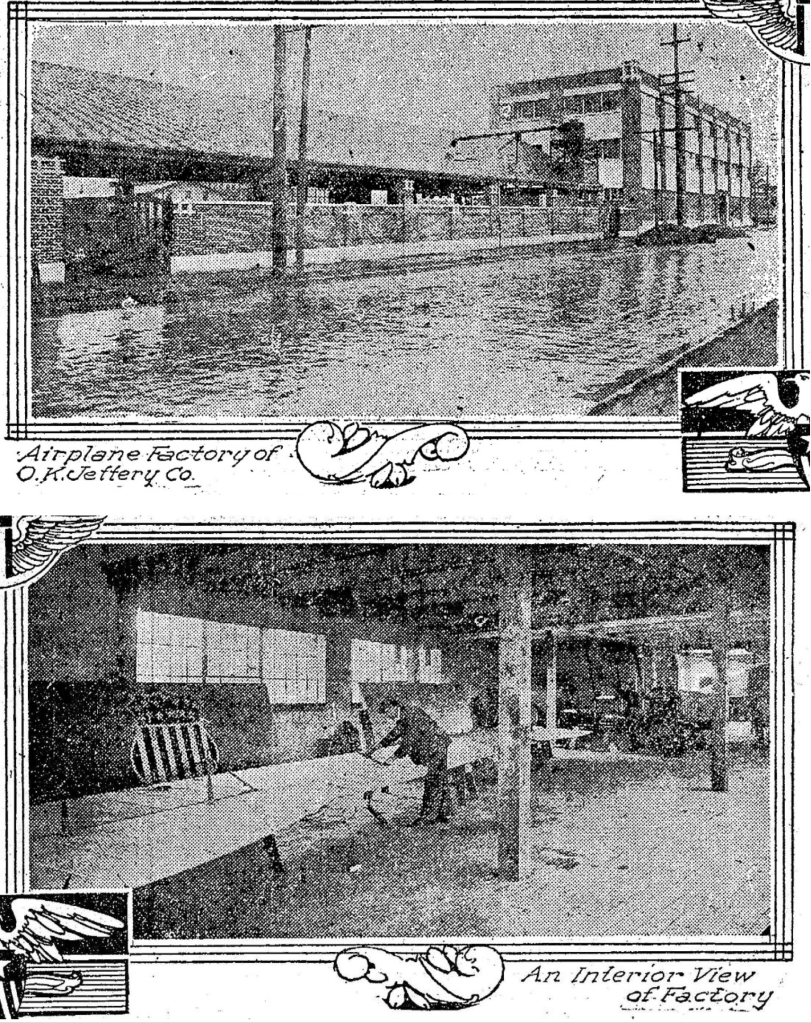
From The Oregonian, January 1, 1918. Top photo looks east on NE Broadway just east of NE 33rd.
In an August 5, 1917 story in The Oregon Journal, Jeffrey was quoted as saying his workers were cutting 25,000 board feet of spruce parts daily for airplane stock and that the product would be shipped to eastern finishing plants. He told reporters: “Large orders for finished material have been secured by my company and the present force of 26 men will soon be doubled.” The plant closed a few months later.
Many different products have been manufactured in this building over the years: excelsior, pasta, furniture. It even hosted street-facing retail including barber shops and diners in the 1940s and 1950s. From the 1960s into the late 1970s, the building was Tarlow Furniture. Today, it’s become a canvas for graffiti artists and vandals while its current owners go through the permit process for redevelopment, which will include ground floor retail and a preschool, with apartments on the second and third floors.
One little-known early Sullivan’s Gulch product was the movie business. The American Lifeograph Film Company started in 1911 as this new industry was just taking hold…for a brief time Portland could have become Hollywood. From its headquarters on the south edge of the gulch at NE 33rd and Wasco, the company made dozens of silent films. But a major fire in March 1923 wiped them out and competition from Hollywood pulled that energy and talent south.
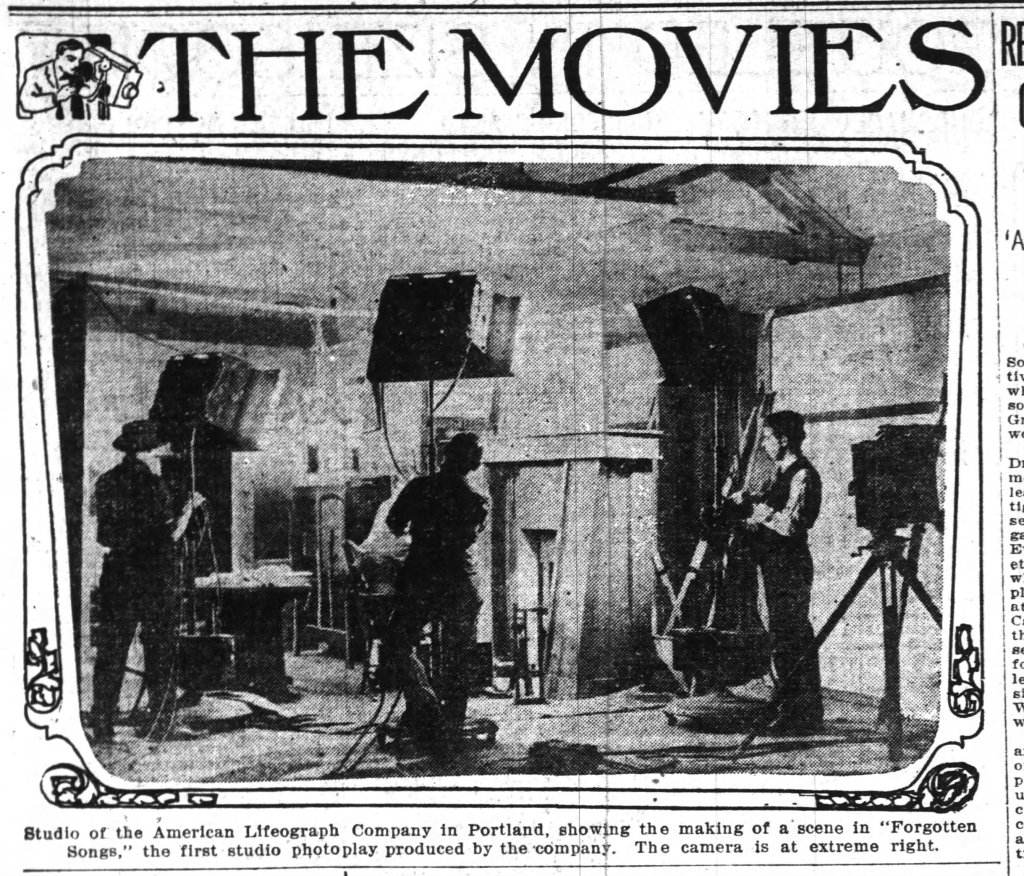
The American Lifeograph Company had a large movie studio building at NE 33rd and Wasco, just a few blocks south of the Oregon Home Builders workshop. This photo shows the studio in a story from the Oregon Journal on February 4, 1914. The studio burned in 1923 ending the company’s presence in Portland.
Aside from all this teeming industry down in the ravine, just getting across the gulch has been a challenge for the ages, and received constant newspaper attention in the early 1900s as the city strategized about bridge construction and how to pay for it. Here’s a look to the south in the teens at the Grand Avenue bridge over the gulch.

Sullivan’s Gulch Grand Avenue Bridge, 1920s, looking south. Source: Oregon Historical Society, Negative 01770
Completion of the 21st street viaduct in October 1912 cost $70,000 and at the time was one of the most modern structures of its kind. The grand opening on October 21, 1912 featured a parade of “loaded auto-trucks, followed by a number of giant steamrollers” as if to make the point that it was sturdy.
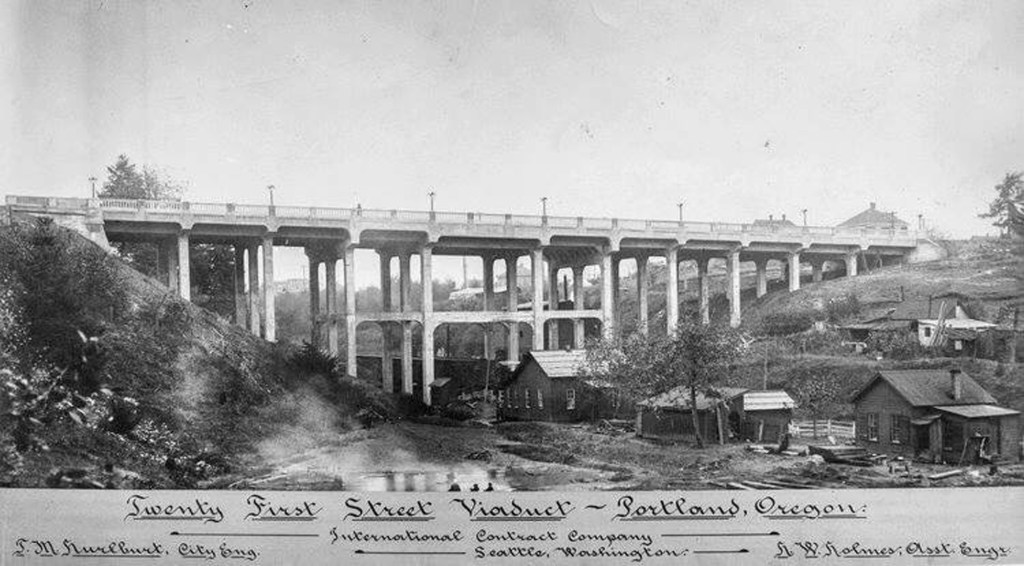
Looking east toward the brand new 21st Street Viaduct, 1912 Source: Oregon Historical Society.
Next: We’ll explore the paradox of the 1930s and 1940s that involved Sullivan’s Gulch becoming—almost simultaneously—home to a high-profile golf course and the location of a giant homeless camp.
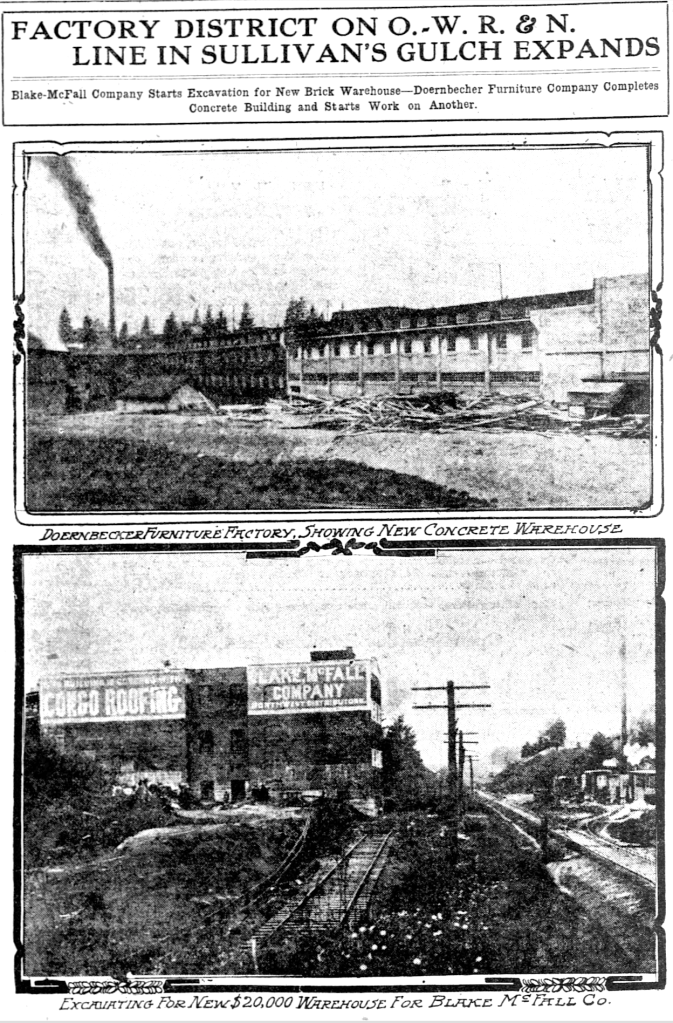

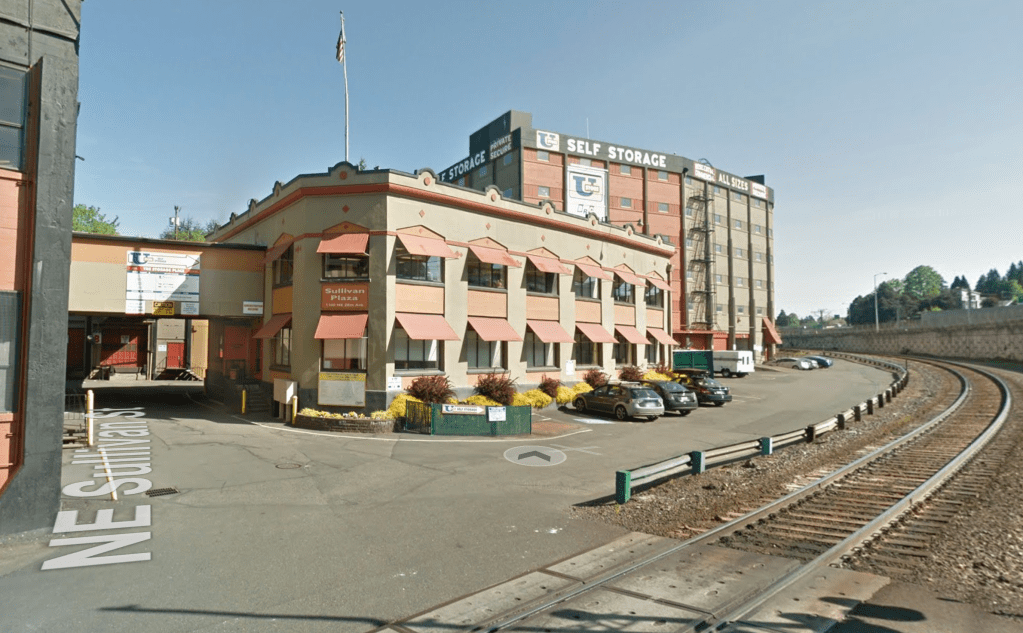

This is so fascinating! The photos are so great! Thank you for these amazing articles. I can’t wait for the next segment!
Doug,
Have you read Susan Stoner’s series of books set in Portland about 1903-ish? They are entertaining historical fiction taking in topics of social justice. There’s one where our hero, Sage Adair, takes on the injustice of the women laundry workers called The Mangle. I am pretty sure it was this one where Sage or his mother visit a poor family with tuberculosis living in Sullivan’s Gulch.
If you haven’t read them, start with the first in the series, Timber Beasts. She goes by S. L. Stoner.
Susan
>
Doernbecher employed virtually all my Volga German relatives, including my grandfather and my uncles. (The area west of NE 15th and north of Fremont was heavily inhabited with German immigrants who came from autonomous German communities in the Volga River basin of Russia.) The location of the Doernbecher factory made it a reasonable walking distance for people who lived in what is now mostly Sabin and King neighborhoods. I still own pieces of furniture made by my uncles with the skills they learned while working there.
Again, a goldmine of information. Even those of us who feel we’ve unearthed many stories of our hometown over the years can find new details and facts from your thorough research. I’m sure people have wondered if it would all be collected into a book at some point-? Thank you for sharing the fruits of your labor!
Doug: I am MIke Bergman´s sister, Jill. Our mom grew up on the corner of 21st and Broadway, where the apartment building, Executive House East, stands now. She used to tell us stories about how, during the Great Depression, “hobos” would climb up from the trains in Sullivan´s Gulch and knock on my grandmother´s back door, asking for work and food. Grandma would give them a small job to do in the yard or around the house and then feed them on the back porch. It was all very peaceful. I thought of this when I read the latest post. Thanks for all your work on this site. You are doing us all a tremendous service, connecting us with the past in the neighborhoods we love so much.
On Fri, Nov 12, 2021 at 2:18 PM Alameda Old House History wrote:
> Doug posted: ” Continuing our four-part series on Sullivan’s Gulch. The > first chapter examined homestead and early railroad history. In this > chapter we explore how manufacturing shaped the area during the first half > of the 20th Century. In the early 1900s, the railr” >